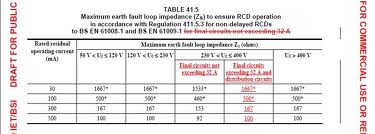Richard asks this question, which concerns electrical testing – in this case in a factory installation – and whether Table 41.3 or 41.5 of BS 7671:2008 should be used. It has been answered by the NICEIC (Theme – Regulations and Legislation):

This Q & A is one of thousands posted in our Technical Expertise area, and answered on a daily basis by our Voltimum Experts.
Question: Noting that for fault protection, the limiting values of earth fault loop impedances, Zs for many overcurrent protective devices are provided in Tables 41.2, 41.3 and 41.4 of BS 7671:2008, I have a query.
I’ve always filled my test sheets in with either regulation values or 80% earth loop impedance values as per Tables 41.3 and 41.4 or 41.5.
I recently tested a factory TN-S electrical installation and found that the measured earth loop impedance readings were on the high side.
However, I’ve been told by the NICEIC qualified manager that all values can be as per Table 41.5, and he showed me Regulation 411.4.9.
Remembering that the maximum earth fault loop impedance should not exceed 1667Ω (Table 41.5 of BS 7671:2008), it now confuses me. As we use RCDs more often if I can submit the 1667Ω value to most circuits, what use are the other tables?
I cannot see what purpose they hold, as most items now are RCD-protected.
Or is the manager wrong?
Answer: Where the overcurrent characteristics of an RCBO to BS EN 61009-1 are able to meet the requirements for automatic disconnection, it is quite legitimate to put the figures from Table 41.3 on a certificate or report. In such instances it is also legitimate to use the figures from Table 41.5 on the certificate or report.
Regulation 411.4.9 states that Table 41.5 may be applied for RCDs where an RCD is used to satisfy the requirements for automatic disconnection. Where the Zs value is over the maximum value in Table 41.3, it is logical to use the figures from Table 41.5 on the certificate or report.
The NICEIC advises using Table 41.3 where the installation has been so designed that the overcurrent characteristics of the RCBO to BS EN 61009-1 are being used for automatic disconnection.
A cautionary note must be added here - a Zs value that is under 1667Ω only ensures that in the event of an earth fault, the RCD or RCBO should operate. It does not confirm that the circuit is totally compliant with other requirements of BS7671. For TN-S or TN-C-S systems, a Zs value significantly above that required by Table 41.3 could indicate a high resistance fault somewhere in the circuit, which - in turn - could pose a fire risk. Also, where an RCD is used for automatic disconnection because of high Zs readings, it must be confirmed that the L-N loop impedance is low enough to ensure that the overcurrent protective device operates before thermal damage occurs to the cable.
To see many more Q & A in Voltimum UK's Experts Area, please click on the link. Experts from leading organisations provide online answers to your technical questions on a broad range of subjects. Our searchable database of existing Q & As now contains over 3,500 entries; you can browse through them here.
